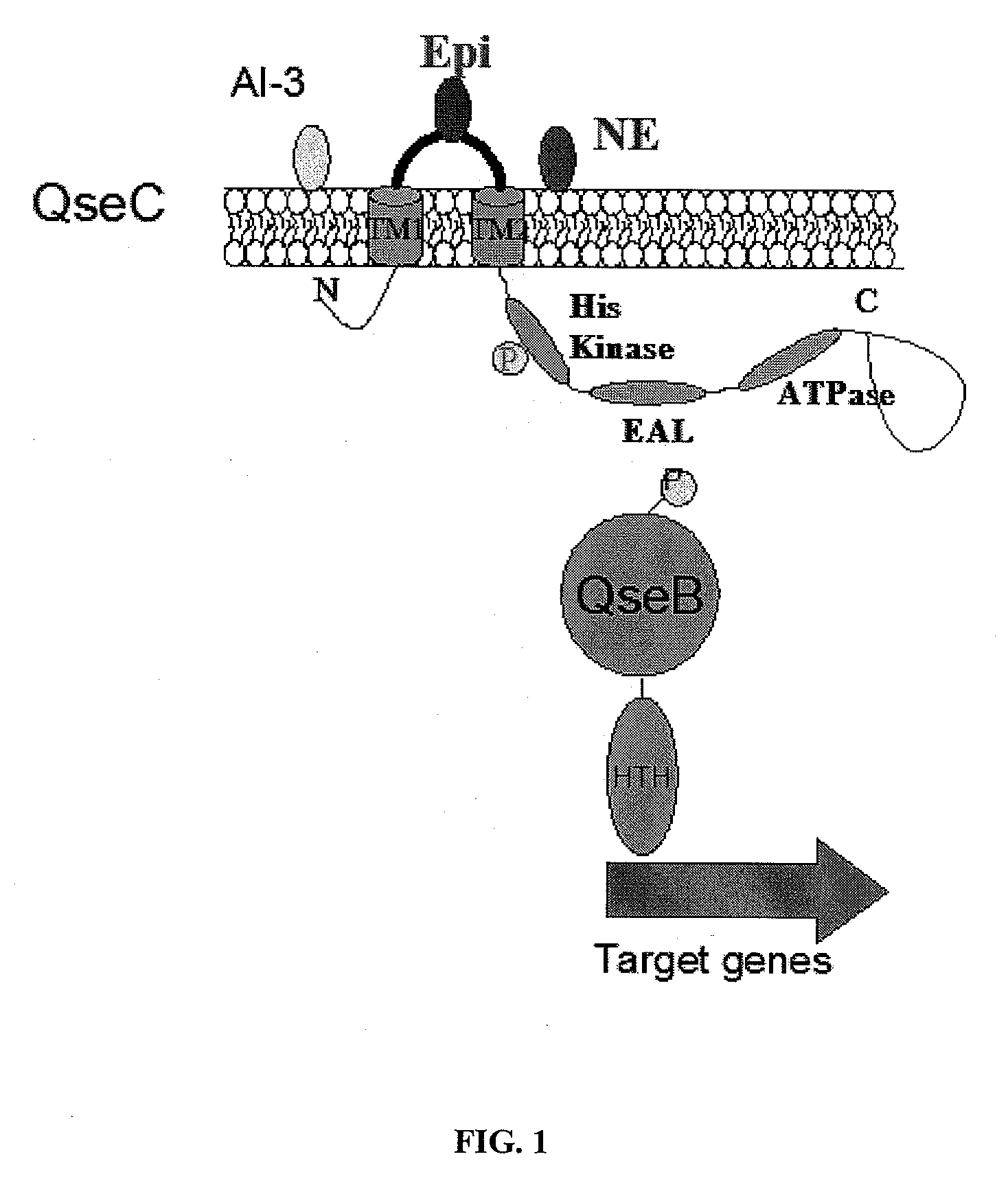Methods of Inhibiting Bacterial Virulence and Compounds Relating Thereto
a bacterial virulence and compound technology, applied in the field of bacteriaology and infectious diseases, can solve the problems of interfere with the ability of bacteria, etc., and achieve the effects of inhibiting bacterial virulence, low evolutionary pressure for bacteria to evolve resistance mechanisms to this type of treatment, and broad applicability
- Summary
- Abstract
- Description
- Claims
- Application Information
AI Technical Summary
Benefits of technology
Problems solved by technology
Method used
Image
Examples
example 1
Screening for Inhibitors of Bacterial Virulence
Overview
[0197]A library of 150,000 small organic molecules from UT Southwestern Medical Center, Dallas, Tex., was screened at 5 μM in a high throughput assay to identify inhibitors of QseC-dependent virulence gene activation in EHEC (FIG. 5). The first round of positive “hits,” represented a diverse range of molecular architecture, was subjected to additional rounds of screening followed by preliminary evaluations for toxicity against bacterial cells in vitro. This yielded a pool of 75 potential inhibitors with IC50 values at or below 10−5 M. One compound was selected based upon its potency compared with other lead molecules, its minimal toxicity towards bacterial and human cell lines, and potential for chemical modification. This molecule was subjected to structure-activity studies to identify ways to improve its potency. The result, LED209 (compound 5) (N-phenyl-4-[[(phenylamino)thioxomethyl]amino]-benzenesulfonamide), was prepared in...
example 2
Preparation of Certain Compounds of the Present Invention
[0201]
[0202]N-Acetylsulfanilyl chloride 1 (55 g, 236 mmol) was added in portion to a stirring, 0° C. suspension of sodium acetate (48.4 g, 590 mmol) and aniline 2 (22 mL, 236 mmol) in ethanol (300 mL). The reaction mixture was stirred at room temperature overnight and then poured into ice-cold water (1.5 L) with vigorous stirring. After stirring for 1 h, the white solid that gradually precipitated was collected by filtration. The filter cake was washed with ice-cold water, dried under vacuum, and recrystallized from hot ethanol to give N-[4-[(phenylamino)sulfonyl]phenyl]acetamide (3) (also called 137-19 or LED137) (41 g, 60%) as a white solid, mp 209-210° C. 1H NMR (CD3OD, 400 MHz) δ 7.64 (br s, 4H), 7.18 (t, J=7.6 Hz, 2H), 7.06-7.00 (m, 3H), 2.10 (s, 3H).
[0203]An aqueous 6N solution of HCl (40 mL) was cautiously added with stirring to a solution of 3 (20 g, 68 mmol) in ethanol (80 mL). After heating under reflux for 3 h, the ...
example 3
LED209 Minimally Affects Adrenergic Signaling
[0269]The observation that epinephrine (epi) binds to the QseC membrane receptor triggering expression of key virulence genes raises obvious concerns that any drug targeting this interaction may also interfere with adrenergic signaling systems operating in the host. Mammalian adrenergic receptors are a class of G protein-coupled receptors that are targets of their endogenous ligands, the catecholamines epinephrine (epi) and norepinephrine (NE) and are activated by these. There are three classes of adrenergic receptors (α1, α2 and β), each containing three members; each class of adrenergic receptors in turn activates a unique isoform of heterotrimeric G proteins that subsequently modulates the activity of key signaling proteins regulating intracellular second messengers.
[0270]As tested in the assay described by Ross et al., 2007, compounds 130969 (*) and LED208 (*) but not LED209 reduce both basal (shown in FIG. 6A) and Iso (β2 adrenergic)...
PUM
| Property | Measurement | Unit |
|---|---|---|
| molecular weight | aaaaa | aaaaa |
| pH | aaaaa | aaaaa |
| pH | aaaaa | aaaaa |
Abstract
Description
Claims
Application Information
 Login to View More
Login to View More - R&D
- Intellectual Property
- Life Sciences
- Materials
- Tech Scout
- Unparalleled Data Quality
- Higher Quality Content
- 60% Fewer Hallucinations
Browse by: Latest US Patents, China's latest patents, Technical Efficacy Thesaurus, Application Domain, Technology Topic, Popular Technical Reports.
© 2025 PatSnap. All rights reserved.Legal|Privacy policy|Modern Slavery Act Transparency Statement|Sitemap|About US| Contact US: help@patsnap.com



